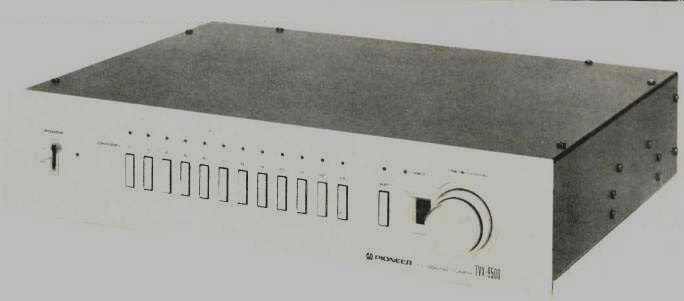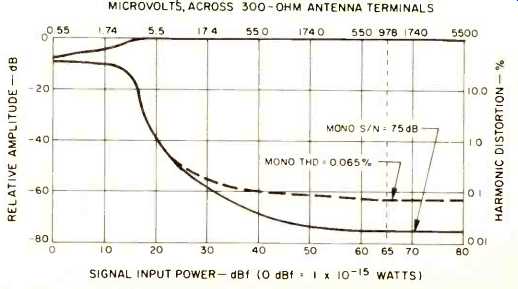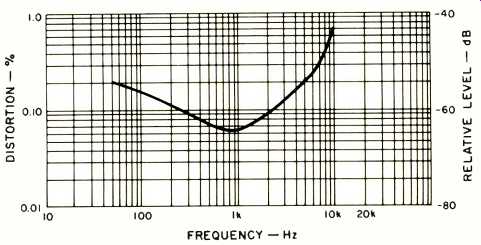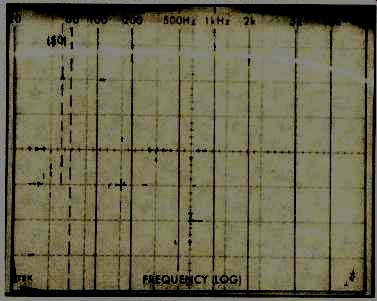
MANUFACTURER'S SPECIFICATIONS:
50-dB Quieting Sensitivity: 32 dBf (22 pV/300 ohms).
S/N Ratio: 65 dB @ 85 dBf.
THD at 65 dBf: 0.7 percent at 100 and 1000 Hz; 0.2 percent at 6 kHz, for ±25 kHz deviation.
Capture Ratio: 1.0 dB.
Alternate Channel Selectivity: 25 dB.
Frequency Response: 50 Hz to 10 kHz,+0.5,-1.0 dB.
Spurious Response Rejection: VHF, 50 dB; UHF, 40 dB.
Image Rejection: VHF, 50 dB; UHF, 40 dB.
I.f. Rejection: VHF, 50 dB; UHF, 55 dB.
AM Suppression: 50 dB.
Muting Threshold: 34.1 dBf (28 NV).
Output Level: 400 mV for 100 percent modulation.
Power Requirements: 120 V, 60 Hz, 12W.
Dimensions: 16 9/16 in. (42 cm) W x 3 7/8 in. (10 cm) H x 13 3/4 in. (35 cm) D.
Weight: 13 lbs., 7 oz. (6.1 kg).
Price: $250.00.
The typical audio enthusiast probably regards the audio portion of TV broadcasts with some disdain. Still, TV sound, as authorized by the FCC, is not only transmitted by FM, but has the very same frequency response potential as FM radio -- 30 to 15,000 Hz. The fact that, up until now, TV sound has been anything but hi-fi is caused by one of those recurring vicious circles that often plague the consumer electronics industry. Initially, TV broadcasters and networks used standard telephone lines to transmit their audio signals to transmitters and to other points in the network. Since those lines, typically, cut off at around 5 kHz, the TV audio that was finally aired was strictly low-fi. TV set manufacturers, aware of this limitation (and rightly more concerned with picture quality), saw no reason to build sophisticated audio systems into their receivers.
Now, however, TV networks are beginning to employ a di-plexing system which permits the audio signals to ride right along on the coaxial cable with the wideband video signals.
Public Service Broadcasting has been using satellite communications to beam both its video and audio signals around the country, and both such techniques lend themselves to wideband audio transmission. Only the TV set manufacturers have been slow to improve the audio capabilities at the receiving end. So, Pioneer decided to fill in the TV audio gap with the introduction of their TVX-9500 TV sound tuner.

Fig. 1--Mono quieting and distortion characteristics of the Pioneer TVX-9500
TV audio tuner.
Styled to complement other components in a high fidelity system, the front panel of the TVX-9500 is equipped with a power switch at the left and twelve slim pushbuttons which are numbered from 2 through 13, corresponding to the VHF TV channels used in the United States. Above each of these buttons is an LED indicator which lights up when the corresponding button is depressed. A thirteenth button, separated from the others, is labeled UHF, and when it is depressed a rotary UHF selector knob comes into play, along with its con centric fine-tune control.
Although the VHF channels are pre-tuned by the factory prior to shipment, fine tuning of these "fixed" selectors i possible, since, under the bottom of the tuner are individual adjustment potentiometers for trimming these frequency selectors, as required. To perform this calibration operation, the user would also turn off the built-in AFC by means of a slide switch also located on the undersurface of the chassis.
With the AFC switch in the Off position, the built-in muting circuit is also temporarily defeated to permit precise adjustment of channel frequencies. When a given TV channel's audio carrier is accurately tuned in, a green LED lights up to indicate that fact.
The rear panel of the TVX-9500 is equipped with two audio output jacks and with 300-ohm balanced UHF and VHF screw terminals, plus a connection terminal for a 75-ohm coaxial transmission line (for VHF only). As readers are surely aware, TV sound as presently broadcast is monophonic, but two audio output jacks are provided to permit connection to both high-level input channels of a stereo component system so that sound will emanate from both loudspeakers. Ideally, the TV set (with its volume control turned down) could then be placed mid-way between the stereo loudspeaker array and TV audio would again seem to emanate from the TV set's location.

Fig. 2 -- Distortion vs. frequency.

Fig. 3 -- Frequency response (each vertical division equals 10dB).
Circuit Highlights
The TVX-9500 circuitry is very much like that of a better-grade FM tuner (which, in a sense, it is). Front ends are electronically tuned (using varactor diodes instead of a continuously variable tuning capacitor). The channel pushbuttons simply connect an appropriate level of d.c. voltage to the diode, thereby determining its effective capacitance in the tuned circuit of the front end. The i.f. circuitry employs a combination of LC and solid-state filters as well as a discrete transistor amplifier followed by a multiple purpose IC amplifier/limiter/quadrature detector. The recovered audio output from the detector is fed to a differential amplifier audio stage, while a d.c. AFC voltage is fed back to the front end in the manner familiar to anyone conversant with FM circuitry.
FM Performance Measurements
The first problem we encountered in trying to measure the performance of the TVX-9500 was to come up with a suitable r.f. signal generator. Like many other consumer electronics engineers, we still own some ancient, if rudimentary, TV servicing equipment but that would hardly do for measuring the performance of a high-fidelity TV sound tuner. Happily, our Sound Technology generator with which we measure all FM tuner and receiver circuitry, though calibrated only from 88 MHz to 108 MHZ, goes a bit below the 88 MHz lower limit and, with the aid of a frequency counter, we adjusted its output to 87.75, the carrier frequency of the audio signal of TV Channel 6.
Thus equipped, we measured performance (only for Channel 6, of course) in much the same way that we would mea sure any FM tuner. It should be noted that standard de-emphasis on TV audio is 75 microseconds--the same value used in FM broadcasting. However, and this is an important difference, maximum audio modulation in TV is only ±25 kHz, as opposed to ±75 kHz used in FM broadcasting. In one respect, that makes it easier for the TV audio tuner designer, while in another sense it makes things more difficult.
Restricted to a ±25 kHz deviation limit, the TV audio tuner has a built-in limitation of 10 dB less in S/N ratio as compared with an FM tuner. We were therefore all the more impressed with the TVX-9500's ultimate S/N ratio, which, as can be seen by examining Fig. 1, reached a high of 75 dB.
Pioneer claimed only 65 dB for S/N and, interestingly, quoted that figure for an 85-dBf input signal strength. The justification for this higher signal input no doubt comes from the fact that, generally speaking, TV transmitter power is much greater than that radiated by most FM radio stations, so Pioneer no doubt presumed that there would be greater available signal strength at the antenna terminals of this product. As indicated in Fig. 1, however, the unit did just as well in quieting with the standard 65-dBf signal normally used to check S/N of FM tuners.
The ±25 kHz deviation proves to be advantageous insofar as distortion is concerned, since the i.f. stages and detector's bandwidth need not be as wide or as linear as is necessary for heavier modulation FM reception. And indeed, the THD at 1 kHz for "full" modulation (remember, ±25 kHz) was an impressively low 0.065 percent. Distortion versus frequency is plotted in Fig. 2, and THD rose to 0.21 percent at 100 Hz and to just over 0.6 percent at 10 kHz.
Note that Pioneer makes no claims for frequency response beyond 10 kHz and, as can be seen from the sweep-frequency plot (Fig. 3) recorded on the 'scope face of our spectrum analyzer, response does start to drop off somewhat above 5 kHz and is attenuated by some 4 to 5 dB at 15 kHz. The 50-dB quieting point is reached with an input signal of 23.3 dBf (8.0 pV/300 ohms), while muting threshold was set for 34.7 dBf (30 pV/300 ohms). We measured a capture ratio of 1.3 dB, and AM suppression measured 50 dB, as claimed. We note that Pioneer provides an alternate channel selectivity specification of 25 dB but cannot imagine what that specification is supposed to convey. It surely does not refer to an audio signal that is 12 MHz removed from the desired signal.
Yet, if it is a measure of the rejection of a signal 400 kHz removed from the desired audio signal, that has no real meaning in the case of TV audio frequency allocations.
Listening and Use Tests
While Pioneer does supply a T-wire indoor dipole antenna for use with the TVX-9500, our own experiences with the product prompt us to strongly advise the use of an outdoor TV antenna, if possible. That old monster "multipath" is every bit as much of a problem here as it is in the case of ordinary FM reception, if not more so. It's hardly ever a question of inadequate signal strength (unless you really live in a TV fringe area), but those reflections can distort received audio from TV stations, even when the signals are fed into a magnificent stereo component system. Using a two-set coupler to your existing TV antenna is a good idea if you can tolerate a couple of dB of signal loss (which, in many cases, won't be detected, either visually or audibly).
Hooked up to an outdoor antenna, the TVX-9500 per formed very well indeed, being limited only by the quality of audio being broadcast by our local TV channels. We were amazed at the variation in audio quality we observed when tuning from channel to channel (or even on the same channel when programming switched from a live-taped studio event to a movie or, even worse, to some commercials. Some of the commercial voices sounded no better than a voice recorded and reproduced by a portable cassette deck). On the other hand, tuning to a fine concert, such as the ones often broadcast by our local Public Broadcasting Service station, was a sheer delight to both eye and ear! All it took was a simple A-B test (turn down the hi-fi volume control and turn up the TV's control) to realize that the potential for good TV sound exists and has always existed.
Now all that remains is for the TV stations around the country to avail themselves of that potential (just using the diplexing method won't help if the program's sound is of low quality to begin with). In the meanwhile, ownership of a tuner such as Pioneer's TVX-9500 will at least enable the user to enjoy the sounds of those programs where audio is worth listening to and to complain to the originators of TV pro grams where the audio is inferior.
-Leonard Feldman
=================
(Audio magazine, Nov. 1978)
Also see:
Pioneer Model F-9 Tuner (Aug. 1981)
Pioneer F-90 Tuner (Jan. 1984)
Pioneer TX-9500-II AM/FM Stereo Tuner (May 1977)
Pioneer Model TX-9100 AM/FM Stereo Tuner (Aug. 1973)
= = = =